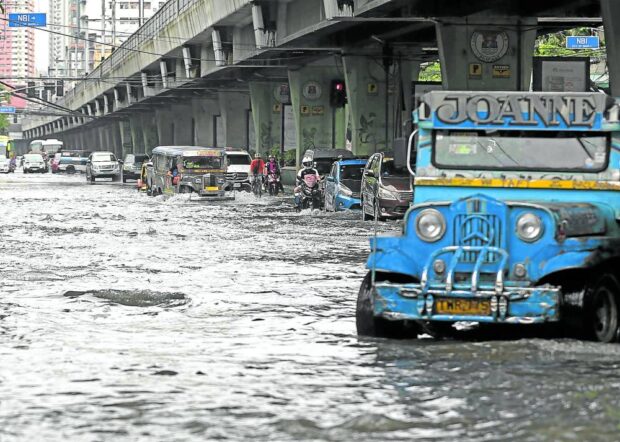
EXPECT THE WORST With a recent government report showing that the rate of sea level rise in Metro Manila has exceeded the global average, expect flooding, like this scene on Taft Avenue in Manila after a heavy downpour on July 30, to worsen. —RICHARD A. REYES
CITY OF BATAC — The sea level rise in Metro Manila is now almost three times the global average, highlighting anew the need to secure the Philippine capital region from the frequent flooding and displacement often associated with this phenomenon.
This was among the findings of the physical oceanography division of the National Mapping and Resource Information Authority (Namria), which presented its report during the coastal engineering summit at Mariano Marcos State University in this city in Ilocos Norte province on Tuesday.
Among others, the agency found that the sea level in Metro Manila has risen by an average of 8.4 millimeters a year from 1901 until 2022, almost three times the global average of 3.4 mm/year during that period.
Excluding the gap years when Namria did not have historical data (this data set covers 1947 to 2022), Metro Manila’s sea levels rose at a rate of 13.2 mm/year.
But when computations are pegged during the start of urbanization in Manila (this data set covers 1965 to 2022), sea levels rose at a higher rate, at 14.2 mm/year.
‘Coupling effect’
Dennis Bringas, division chief, said this was in part because of the “coupling effect” of land subsidence, or the gradual sinking of the Earth’s surface, and sea level rise.
In the case of Metro Manila, he said, man-made activities like excessive groundwater extraction, deforestation, and land reclamation may have greatly contributed to these high rates of sea level rise.
However, it was “still too early to say” whether the ongoing reclamation activities across Manila Bay could have made it worse, he told the Inquirer.
Many of the dump-and-fill projects in the bay intensified only in the past six years, where at least three projects were already underway before President Marcos ordered the suspension of all reclamation activities there.
Fernando Siringan, a marine scientist and geologist from the University of the Philippines’ Marine Science Institute, said reclamation and seabed mining activities in the bay could cause coastal erosion around the areas.
This would leave communities even more vulnerable to flooding, he added.
How other cities fare
Apart from Metro Manila, Namria also measured the monthly mean sea level trends across 12 other coastal areas in the country.
Legazpi City, the provincial capital of Albay, is second to the capital region with a sea level rise average of 6 mm/year over a 76-year period. This was followed by Surigao and Puerto Princesa cities (4.8 mm/year); and Davao City and Real, Quezon (3.6 mm/year), all of which posted rates higher than the global average.
But there are outliers. Some cities, like Cebu, were only seeing a 1.2 mm/year sea level rise over the past 75 years, while others like San Fernando City in La Union and Zamboanga City were seeing a decline in sea levels.
Bringas said that while climate change research was not part of Namria’s mandate, its historical records and modeling on sea level were critical to understanding and predicting the impacts of this phenomenon.
Engineering needs
Enrico Paringit, executive director of the Department of Science and Technology’s Philippine Council for Industry, Energy and Emerging Industries Research and Development, said the threat of sea level rise highlights the need to invest in more coastal engineering infrastructure and monitoring.
However, achieving coastal resilience was “still quite difficult,” he said, “because we’re only just starting in this field (coastal engineering).”
The phenomenon, which is caused by the melting of glaciers and the expansion of ocean water due to rising temperatures, places coastal megacities around the world at grave risk of flooding and, at worst, going underwater.
In Metro Manila alone, coastal flooding events are predicted to occur between 18 to 96 times more often by 2100, according to a study led by the French National Center for Scientific Research published in March this year.
READ: PH sea level rising 3 times faster than world average, says expert